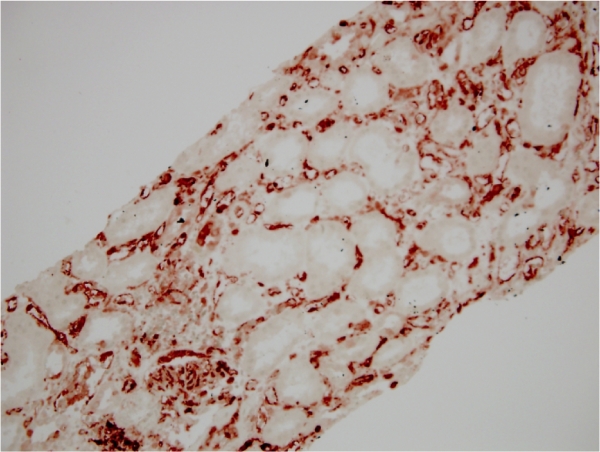Markers of Activation of Microvascular Endothelial Cells Predict a Poor Long-Term Graft Outcome in Early Renal Graft Biopsies Displaying Acute Tubular Necrosis.
1INSERM UMR_S1155, INSERM, Paris, France
2Pathology, APHP, Hoptal Tenon, Paris, France
3HLA Institute, INSERM_S940, Paris, France.
Meeting: 2016 American Transplant Congress
Abstract number: C178
Keywords: Endothelial activation, Graft function, Ischemia, Prognosis
Session Information
Session Name: Poster Session C: Kidney Transplantation: AKI/Preservation/DCD
Session Type: Poster Session
Date: Monday, June 13, 2016
Session Time: 6:00pm-7:00pm
 Presentation Time: 6:00pm-7:00pm
Presentation Time: 6:00pm-7:00pm
Location: Halls C&D
Acute tubular necrosis (ATN), is a histopathological feature frequently seen in the early post renal transplant biopsies taken from patients with delayed graft function (DGF). Since DGF decreases graft survival in the long term, we need to understand mechanisms at stake, and to identify early biomarkers for patients in whom ATN/DGF will have harmful consequences.
In this study, we included 41 kidney recipients with impaired early graft function requiring a biopsy during the first month after transplantation, and in whom the biopsy showed ATN lesions. We studied markers of microvascular endothelial activation (fascin, vimentin, characteristic of endothelial to mesenchymal transition or EndMT) and of tubular phenotypic changes (vimentin, kim1) by immunohistochemistry, according to a semi-quantitative score. The extent of ATN was also measured semi-quantitatively and correlated with graft dysfunction at the time of the biopsy. However extensive ATN per se was not associated with a poor long-term graft outcome unless endothelial cell activation markers were expressed (rho -0.55, p<0.001). In this subgroup (ATN/EndMT+) both the extent of ATN and vimentin expression in the injured tubules predicted graft dysfunction at the time point of 24 months post-Tx. A strong fascin staining in peri-tubular capillaries in the setting of ATN is shown on Figure 1  .
.
These results suggest that endothelial cell injury or activation at the early phase of an acute kidney injury reflects the severity of ischemia-reperfusion, and is clinically relevant.
CITATION INFORMATION: Dubois-Xu Y.-C, Ahmadpoor P, Corchia A, Buob D, Galichon P, Brochériou I, Suberbielle C, Hertig A, Rondeau E. Markers of Activation of Microvascular Endothelial Cells Predict a Poor Long-Term Graft Outcome in Early Renal Graft Biopsies Displaying Acute Tubular Necrosis. Am J Transplant. 2016;16 (suppl 3).
To cite this abstract in AMA style:
Dubois-Xu Y-C, Ahmadpoor P, Corchia A, Buob D, Galichon P, Brochériou I, Suberbielle C, Hertig A, Rondeau E. Markers of Activation of Microvascular Endothelial Cells Predict a Poor Long-Term Graft Outcome in Early Renal Graft Biopsies Displaying Acute Tubular Necrosis. [abstract]. Am J Transplant. 2016; 16 (suppl 3). https://atcmeetingabstracts.com/abstract/markers-of-activation-of-microvascular-endothelial-cells-predict-a-poor-long-term-graft-outcome-in-early-renal-graft-biopsies-displaying-acute-tubular-necrosis/. Accessed December 28, 2025.« Back to 2016 American Transplant Congress
